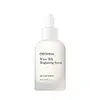What's inside
What's inside
 Key Ingredients
Key Ingredients

 Benefits
Benefits

 Concerns
Concerns

 Ingredients Side-by-side
Ingredients Side-by-side

Water
Skin ConditioningGlycerin
HumectantDimethicone
EmollientAcetyl Glucosamine
Skin ConditioningPropylene Glycol
HumectantDimethiconol
EmollientPhenoxyethanol
PreservativeCarbomer
Emulsion StabilisingTetrahydrodiferuloylmethane
AntioxidantHexylresorcinol
AntimicrobialDisodium EDTA
Sodium Hydroxide
BufferingDimethicone/Vinyl Dimethicone Crosspolymer
Skin ConditioningPentylene Glycol
Skin ConditioningParfum
MaskingAmodimethicone
Ethylhexylglycerin
Skin ConditioningSilica
AbrasiveMica
Cosmetic ColorantTitanium Dioxide
Cosmetic ColorantWater, Glycerin, Dimethicone, Acetyl Glucosamine, Propylene Glycol, Dimethiconol, Phenoxyethanol, Carbomer, Tetrahydrodiferuloylmethane, Hexylresorcinol, Disodium EDTA, Sodium Hydroxide, Dimethicone/Vinyl Dimethicone Crosspolymer, Pentylene Glycol, Parfum, Amodimethicone, Ethylhexylglycerin, Silica, Mica, Titanium Dioxide
Milk Protein
Skin ConditioningWater
Skin ConditioningBetula Platyphylla Japonica Juice
Skin ConditioningChamaecyparis Obtusa Water
MaskingDiphenylsiloxy Phenyl Trimethicone
Skin ConditioningNiacinamide
SmoothingDipropylene Glycol
HumectantPentaerythrityl Tetraethylhexanoate
EmollientButylene Glycol
HumectantGlycerin
HumectantPentylene Glycol
Skin Conditioning1,2-Hexanediol
Skin ConditioningHamamelis Virginiana Water
AstringentCentella Asiatica Extract
CleansingCaprylic/Capric Triglyceride
MaskingGlyceryl Caprylate
EmollientHydrogenated Lecithin
EmulsifyingCeramide NP
Skin ConditioningSodium PCA
HumectantSodium Stearoyl Glutamate
CleansingEthylhexylglycerin
Skin ConditioningSorbitan Isostearate
EmulsifyingPanthenol
Skin ConditioningColostrum
Skin ConditioningArbutin
AntioxidantBisabolol
MaskingHydroxyethyl Acrylate/Sodium Acryloyldimethyl Taurate Copolymer
Emulsion StabilisingDimethicone
EmollientTocopherol
AntioxidantGlutathione
Carbomer
Emulsion StabilisingBehenyl Alcohol
EmollientXanthan Gum
EmulsifyingTranexamic Acid
AstringentTromethamine
BufferingChondrus Crispus Extract
Skin ConditioningSaccharum Officinarum Extract
MoisturisingPortulaca Oleracea Extract
Skin ConditioningMilk Protein, Water, Betula Platyphylla Japonica Juice, Chamaecyparis Obtusa Water, Diphenylsiloxy Phenyl Trimethicone, Niacinamide, Dipropylene Glycol, Pentaerythrityl Tetraethylhexanoate, Butylene Glycol, Glycerin, Pentylene Glycol, 1,2-Hexanediol, Hamamelis Virginiana Water, Centella Asiatica Extract, Caprylic/Capric Triglyceride, Glyceryl Caprylate, Hydrogenated Lecithin, Ceramide NP, Sodium PCA, Sodium Stearoyl Glutamate, Ethylhexylglycerin, Sorbitan Isostearate, Panthenol, Colostrum, Arbutin, Bisabolol, Hydroxyethyl Acrylate/Sodium Acryloyldimethyl Taurate Copolymer, Dimethicone, Tocopherol, Glutathione, Carbomer, Behenyl Alcohol, Xanthan Gum, Tranexamic Acid, Tromethamine, Chondrus Crispus Extract, Saccharum Officinarum Extract, Portulaca Oleracea Extract
Ingredients Explained
These ingredients are found in both products.
Ingredients higher up in an ingredient list are typically present in a larger amount.
Carbomer is a polymer of acrylic acid. Its main role is to create a gel consistency.
A high amount of carbomer can cause pilling or balling up of products. Don't worry, most products contain 1% or less of carbomer.
Dimethicone is a type of synthetic silicone created from natural materials such as quartz.
What it does:
Dimethicone comes in different viscosities:
Depending on the viscosity, dimethicone has different properties.
Ingredients lists don't always show which type is used, so we recommend reaching out to the brand if you have questions about the viscosity.
This ingredient is unlikely to cause irritation because it does not get absorbed into skin. However, people with silicone allergies should be careful about using this ingredient.
Note: Dimethicone may contribute to pilling. This is because it is not oil or water soluble, so pilling may occur when layered with products. When mixed with heavy oils in a formula, the outcome is also quite greasy.
Learn more about DimethiconeEthylhexylglycerin (we can't pronounce this either) is commonly used as a preservative and skin softener. It is derived from glyceryl.
You might see Ethylhexylglycerin often paired with other preservatives such as phenoxyethanol. Ethylhexylglycerin has been found to increase the effectiveness of these other preservatives.
Glycerin is already naturally found in your skin. It helps moisturize and protect your skin.
A study from 2016 found glycerin to be more effective as a humectant than AHAs and hyaluronic acid.
As a humectant, it helps the skin stay hydrated by pulling moisture to your skin. The low molecular weight of glycerin allows it to pull moisture into the deeper layers of your skin.
Hydrated skin improves your skin barrier; Your skin barrier helps protect against irritants and bacteria.
Glycerin has also been found to have antimicrobial and antiviral properties. Due to these properties, glycerin is often used in wound and burn treatments.
In cosmetics, glycerin is usually derived from plants such as soybean or palm. However, it can also be sourced from animals, such as tallow or animal fat.
This ingredient is organic, colorless, odorless, and non-toxic.
Glycerin is the name for this ingredient in American English. British English uses Glycerol/Glycerine.
Learn more about GlycerinPentylene glycol is typically used within a product to thicken it. It also adds a smooth, soft, and moisturizing feel to the product. It is naturally found in plants such as sugar beets.
The hydrophilic trait of Pentylene Glycol makes it a humectant. As a humectant, Pentylene Glycol helps draw moisture from the air to your skin. This can help keep your skin hydrated.
This property also makes Pentylene Glycol a great texture enhancer. It can also help thicken or stabilize a product.
Pentylene Glycol also acts as a mild preservative and helps to keep a product microbe-free.
Some people may experience mild eye and skin irritation from Pentylene Glycol. We always recommend speaking with a professional about using this ingredient in your routine.
Pentylene Glycol has a low molecular weight and is part of the 1,2-glycol family.
Learn more about Pentylene GlycolWater. It's the most common cosmetic ingredient of all. You'll usually see it at the top of ingredient lists, meaning that it makes up the largest part of the product.
So why is it so popular? Water most often acts as a solvent - this means that it helps dissolve other ingredients into the formulation.
You'll also recognize water as that liquid we all need to stay alive. If you see this, drink a glass of water. Stay hydrated!
Learn more about Water